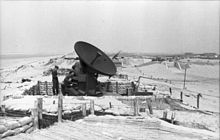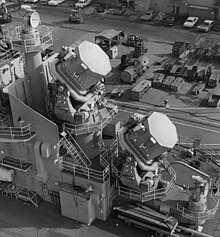Fire control radar
A fire control ( FLR , also called " tracking Radar ", " tracking radar " or " target tracking radar ") is used for the steering of radar-guided missiles and aircraft guns . A - mostly movable - target is tracked with a radar system with the purpose of manually or automatically transferring the position thus determined to a weapon system.
Aligning the FLR with foreign objects can be seen as an aggressive act.
technology
Fire control radars differ significantly from search radars in terms of their structure and functionality . As a rule, they cannot identify targets independently, as their special construction with a very high pulse repetition frequency , narrow main lobe and short transmission pulses is unsuitable for a large-scale target search. Therefore, a search radar must also be available as a supplement, which determines the exact position of the target for the fire control radar. Only then is it possible for the fire control radar to align itself with the target, to record it and to follow it continuously (English tracking ). Due to its special design features (see above), the fire control radar can continuously deliver target data with very high precision, which are necessary for the control of semi-active , beam-riding or command- guided missiles and cannot be supplied by a search radar. Anti-aircraft cannons and ship guns also benefit from the high precision of the target data, as these now enable the tubes to be precisely aligned.
development

Early systems are mostly CW or FMCW radars . Later, pulse radar devices with special antennas were used, which used the method of minimum bearing . Today systems based on the Doppler pulse or the monopulse method are primarily used. There is also a development towards multifunction radars , which can combine the functions of search and fire control radars, such as APAR .
In the case of combat aircraft , this merger was carried out early on, as there was usually no space for two separate radars in the narrow fuselage . However, this leads to a significant reduction in efficiency when using some guided missiles (e.g. AIM-7 Sparrow ), as the system has to constantly switch between fire control and search mode. New multifunction radars like AN / APG-63 (V) 2 represent a solution to this problem.
More recently, phased array antennas are increasingly being used in fire control radars , the electronic beam pivoting and focusing of which enable faster and more accurate target tracking.
See also
Individual evidence
- ^ Matthias Kolb, Paul-Anton Krüger: France accuses Turkey of "extremely aggressive" behavior. In: Zeit Online . July 1, 2020, accessed July 1, 2020 .
